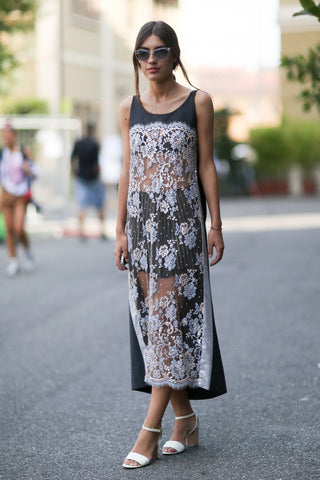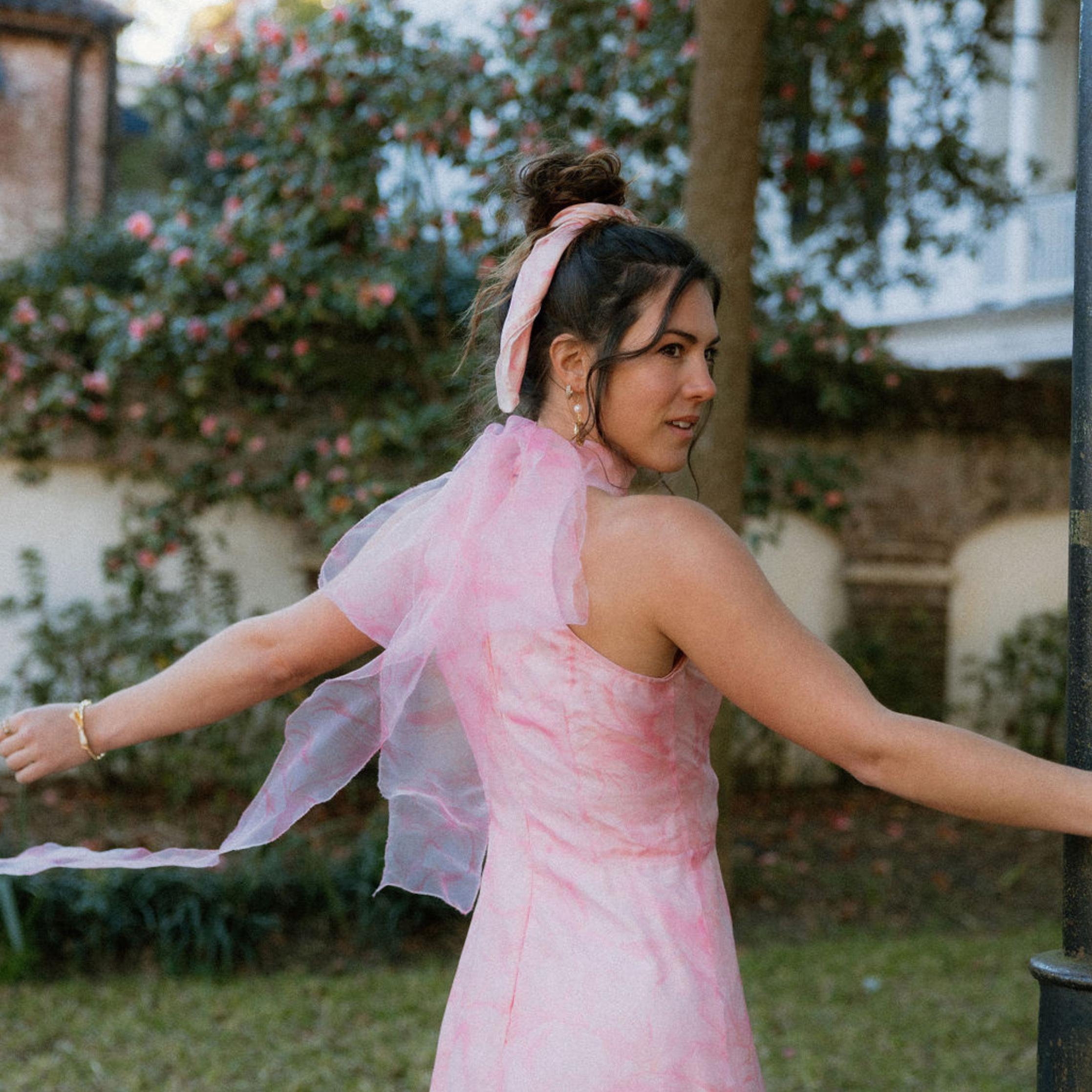How to Choose Fashion Fabrics with a Trip to Mood Fabrics | Terminology and Shopping Tips

In this blog, I am going to talk about choosing fabrics for fashion by covering topics like classification, fibers, and other useful terminology when shopping. Fabric stores can be so overwhelming, so I’ll be going over a few things to help you choose fabric for your own clothing designs and hopefully give you a better understanding of fashion fabrics. I could talk about this subject for hours, so I am going to try to sum it up as best as I can. :)
We are going to go over 1) categorizing fabrics and key words associated. Then we will go over 2) common fabrics and go over uses. Lastly, I will talk about 3) my personal tips for navigating a fabric store and what to be aware of.
1. Categorizing Fabrics
Structure
One of the first things to consider when choosing a fabric is do you need a woven fabric or a knit fabric. Woven fabrics are produced in a loom with the threads overlapping. Think of a basket weave at a much smaller scale. Woven fabrics don’t typically have a lot of stretch and have good shape retention. They are typically easier to sew with as well, so if you are just starting out. That’s a great place to start.

Side note: I know there are exceptions to this, I’m just waiting for the comments to come in, but overall these are general characteristics accepted about the structure of the weave.
The other type of fabric is knits. Knits are made differently. Think of a chunky sweater and the loops that it consists of. This is what knit fabrics look like at a smaller scale. Knits move beautifully and stretch.

Choosing between these fabrics largely depends on the end use, as well as the construction of the garment.
Fibers
Another way to categorize fabrics is to look at what it’s made of. There are three types of fibers: natural, synthetic, and semi synthetic. Natural fibers are harvested and include cotton, linen, silk, wool, cashmere, and hemp. Synthetic fibers are chemically made. There are so many of these but common ones include nylon, acrylic, polyester, and spandex. Lastly, semi synthetic fibers may have a cellulose base but are modified artificially in some way and include rayon and lyocell.
Natural fibers are typically more expensive but synthetic fibers have been created to mimic their properties. Choosing between these two types comes down to preference and ethics. Some people don’t like how synthetic fibers are not as biodegradable but there’s the other side of that doesn’t agree with how natural fibers are procured if it comes from an animal. Some people judge by the way it feels or the “hand”.
2. Common Fabrics and Their Uses
If you are choosing fabrics for warmer weather I would recommend choosing cotton, rayon, chambray, knits, silks, or linen. Another thing to keep in mind is the weight. Weights can range from light weight where the fabric is almost transparent to heavy weight where it’s much stiffer and has more thermal retention. A medium weight cotton would be perfect for a button up or maybe a summer dress.
Rayon is very soft and lightweight and breathable. It absorbs color very well, so it comes in lots of prints and colors. It is very delicate and great for movement.

Chambray is smooth and lightweight but stiffer and durable so it’s good for dress shirts or shorts.

Knits are great for covering the curves of your body and come in a wide range of weights and fibers.

Silk fabric is lightweight and delicate. Its breathable and tends to be slippery, so it can be challenging for beginners. It naturally has a luxurious hand, so it suits dresses.

Linen is the last fabric I recommend for summer. It is very breathable. Keep in mind it wrinkles easily, it doesn’t give as much of a crisp looks as a chambray or cotton.

Although some of those fabrics can transition to fall /winter, cooler weather brings about other heavier fabrics like denim, fur, faux fur, leather, flannel, fleece, and flannel. These fabrics are heavy and better insulators.
Denim has no drape and is very stiff. If you blend it with spandex it can curve with your body like skinny jeans.

Flannel is very soft and insulating. They’re good for comfy pajamas. Fleece is very similar and is great for hoodies or crewnecks and are in the medium to heavy weight range. It’s usually made of polyester.

Wool comes in a broad range of weights and is very insulating. It’s durable. You can see it used in wool suits or even peacoats.

Faux fur is not as durable or insulating as real fur but both are heavyweight and can be used as an accent piece. Faux fur is less expensive.

Leather is typically heavyweight and hard to sew. Once you sew through it, you can’t get rid of the holes, so that’s one reason why it is very expensive. You can use it for jackets or bags.

The last category I’ll mention is formal. Here we have tulle, crinoline, chiffon, satin, lace, and velvet
Tulle and crinoline are a form of netting. Tulle can be used as an accent or for decorative uses. Crinoline is the stiffer of the two and provides more structure.

Chiffon is transparent and flowy. Silk chiffon is very expensive. Polyester is going to be more affordable but not feel as soft.

Satin is the shiny glossy fabric, you see on things like wedding dresses. It’s structure involves floats on top of the fabric, so it is woven differently.

Lace comes in silk or cotton thread and is woven to create a pattern. It is difficult to manufacture and thus more expensive.

The last fabric I’ll mention today is velvet. Velvet is formed by a pile of threads on top of the fabric. It’s very soft and insulating. The most expensive type is silk. It has a shimmer to it.

3. Shopping Tips
Fabric is bought by the yard, and it is important to at least have an idea of how much you need. And when you are looking for fabrics to note what the width is. This may affect how much fabric you want to get.
You can always ask how narrow they are willing to break down the yards. You may need a little more than a yard but they are only willing to break the yards in half. Just ask!
Another thing to look out for is the shrinkage of a fabric. A fabric may shrink upon washing, so you may want to buy extra, wash it before sewing it, and then make your garment. This happens to flannel for example. It can lose 20% of its original size.
Also note the direction of a print. If there is a certain design on it, and it matters that all the design is showing, this matters. If you have a bunch of small pattern pieces and the print on the fabric is huge, you’re going to end up chopping off the print.
Lastly, think about the end use of the fabric. Is it going to be durable, warm, cool, drape-y, stiff? Will the design you want to create work? In fast fashion they often use fibers that aren’t meant to last because it is cheaper to manufacture. Cheap fabrics tend to lose shape, age faster, and lose color. So how long do you want to wear these clothes and how much does this matter to you?
Now we’re going to head to Mood. I always make sure I have a little mood board put together with the vibe and aesthetic I am going for, along with swatches I Already picked out and most importantly sketches of my designs.
Getting to touch and interact with fabric is extremely important in developing a collection.
If you’re nervous about how much to order, I would just get two yards. This is usually enough for a ready to wear garment. Some places will allow you to just get swatches, too. So you can take the swatches home, and you have time to consider what you need
If you’re a beginner, ask for help and don’t start with expensive fabrics, so if you make mistakes on the fabric, you won’t stress out too much. It’s a learning process!
Watch the full YouTube video here:
Comment below if you’d like me to do more videos/blogs on fabrics, and let me know if you have any questions or specific topics you’d like me to cover. Subscribe to my channel and click the bell to get notified when I upload new blogs every Friday!. Thanks for watching and have a great day!
What to watch next?
Watch this video on How to tell Poor vs Good Quality Clothing with a Trip to Rodeo Drive
Watch this video on How to Make a Mood Board
Watch this video on How to Draw the Fashion Figure Part 1:
Follow me on:





